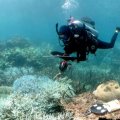Australia is in a strong position to participate as suppliers, rather than as purchasers of services, in advanced space technology, according to a leading UQ space researcher.
Professor Richard Morgan said space-based services formed an increasing sector of the international business market.
“The impact of the Global Positioning System has added an estimated $US40 billion to the annual gross national product of the US alone,” he said. “Australia can maintain a niche role in this area. Countries which do not contribute actively will be disadvantaged.”
Professor Morgan is Director of UQ’s Centre for Hypersonics, the largest group of hypersonics researchers in Australia and the largest University-based hypersonics group in the world. Hypersonics is the study of velocities of Mach number five (five times the speed of sound or more).
Professor Morgan said UQ’s Centre for Hypersonics played a leading role in developing ground-test facilities for simulating hypervelocity flight. The latest high-speed facilities worldwide were based on techniques developed at UQ and by collaborators at ANU.
“US$100 million worth of ground-test facilities based on copies of UQ designs have been built around the world in Germany, Japan, US and France,” he said. “These facilities – shock tunnels and super orbital expansion tubes – are an export industry for Australia, resulting in $10 million export income to the country.”
UQ’s Centre for Hypersonics currently houses some of the world’s most advanced equipment for simulating hypervelocity flows of eight times the speed of sound to 50 times the speed of sound, the speeds experienced by re-entry vehicles such as space shuttles and after interplanetary missions.
Professor Morgan said the expansion tube facilities at UQ were unique, and represented the only means available for testing superorbital aerodynamic flows in the laboratory.
He recently received two Institution of Engineers Australia (IEAust) – Queensland Engineering Excellence Awards which recognise the University’s superorbital spaceflight test facilities. Professor Morgan collected the prestigious RW Hawken (Overall) Award and the Excellence Award in the Research and Development category for outstanding work in the global space research industry.
Professor Morgan has designed, developed and commissioned UQ’s series of high-speed wind-tunnels, known as superorbital expansion tubes, to study the aerodynamics of re-entry flight in the atmospheres of the solar system and beyond.
The project builds on hypersonics technology developed in Australia over the past 40 years, including the work of Emeritus Professor Ray Stalker and Professor Allan Paull. It has culminated in commissioning the largest expansion tube in the world, UQ’s X3 facility.
“This facility opens up the possibility of laboratory testing of new spacecraft concepts at speeds never before possible,” Professor Morgan said. “The facility can be charged with gas mixtures representative of the atmospheres of selected planets, and real flight speeds can be achieved on heavily instrumented models to measure their operating characteristics.”
Professor Morgan said missions which were now possible to simulate at UQ included:
_ Return of astronauts from beyond the Earth’s gravity well at speeds higher than escape velocity, (eg Apollo moon return capsule, return of Martian explorers);
_ Entry of probes into the atmospheres of the outer planets, and visits to moons with atmospheres (eg Titan and Triton);
_ Return to Earth of sample return missions from planets, moons, asteroids and comets;
_ Testing of aero-gravity assisted fly-by waverider vehicles; and
_ Simulation of flight in the atmospheres of planets from other solar systems which have been discovered through space-based sensing.
“This sort of work currently cannot be performed in any other facilities in the world, and the technology will help maintain a role for Australia as a collaborator in multinational development projects of the future,” Professor Morgan said.
Professor Morgan said in early testing in the X3 tunnel, a model “waverider” aeroshell designed by Dr Ramesh from the Centre for Hypersonics had been flown at superorbital speeds for the first time. The waverider is a revolutionary concept, which “surfs” through the upper atmospheres of the planets flying upside-down in a so-called aerogravity assist manoeuvre generating lift to get a slingshot increase in velocity from the planets orbital motion. Such vehicles require very high performance in terms of lift-to-drag ratios in order to be successful, and they will not be able to fly unless the flight characteristics can be demonstrated by ground-testing on facilities such as X3.
According to Professor Morgan, potentially, these craft could offer a spectacular increase in the range of planetary encounter missions which could be flown. The value was in achieving reliable aerodynamic performance data in realistic simulated flight conditions.
UQ’s X 2 facility (a prototype for X3) recently was used to test an “inflatable ballute” re-entry capsule for the NASA Jet Propulsion laboratory using a speed of 12,700 m/sec in simulated Jovian atmosphere. This futuristic concept offers the potential to expand the number of options available for space designers by using light-weight, deployable heat-shields, which may be up to hundreds of metres in diameter. The X2 experiments were the first time the concept had been tested at representative superorbital conditions.
In an alternative operating mode developed by Dr Mike Macrossan and Dr David Mee, the expansion tubes can be used to study the rarefied flows encountered in the very upper reaches of flight at the boundary between space and the atmosphere where changes may occur in spacecraft behaviour and experimental data is very valuable and scarce.
Other notable Centre for Hypersonics projects include the successful HyShot scramjet testing and development and the Mars Gravity Biosatellite program, which aims to pave the way for human exploration of Mars.
“The scientific significance of all these projects is that the design of the current generation of space craft can be improved by detailed lab-testing and analysis,” Professor Morgan said. “Our facilities are also assisting to develop new generations of advanced space craft designed with a much higher degree of precision and understanding than currently used ‘simple’ concepts.”
The project has been supported by the Australian Research Council and The University of Queensland.
Media: Further information, contact Professor Richard Morgan (telephone 07 3365 3592).
.jpg)


